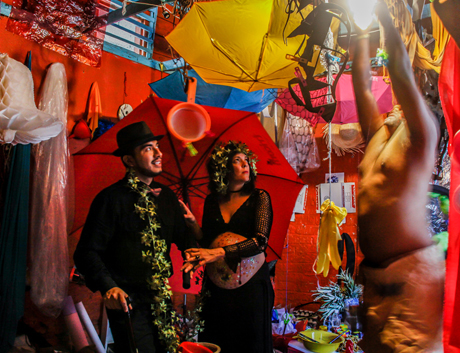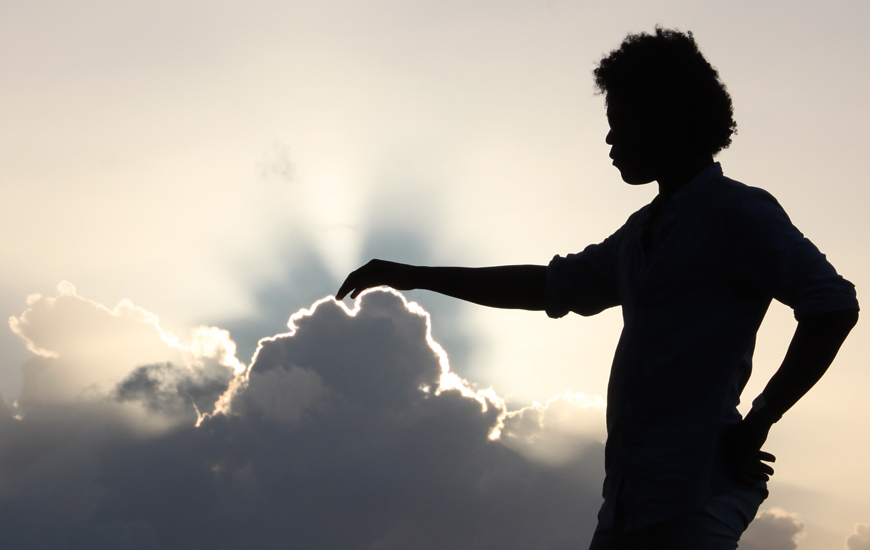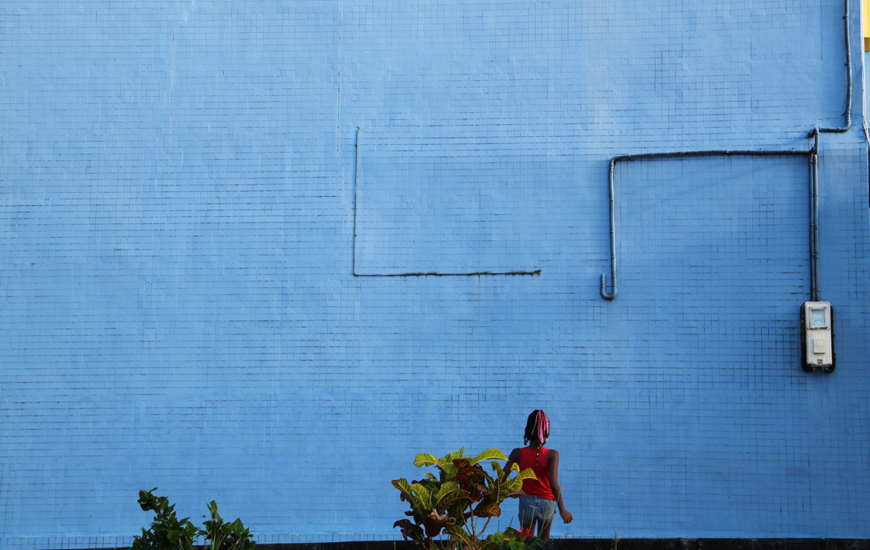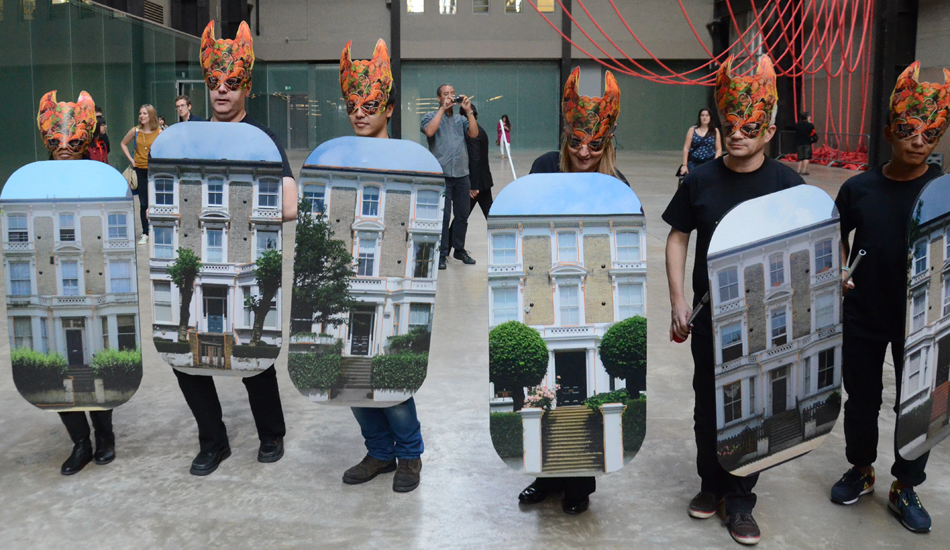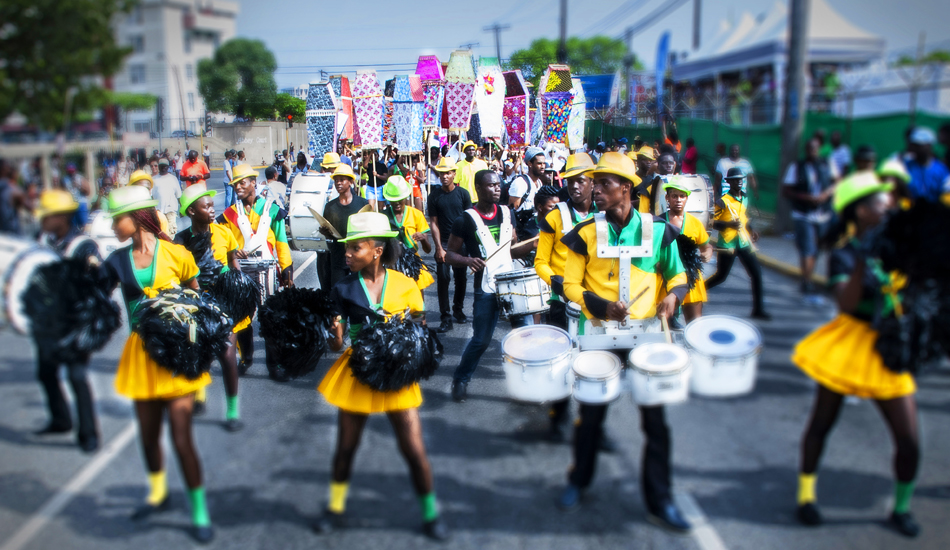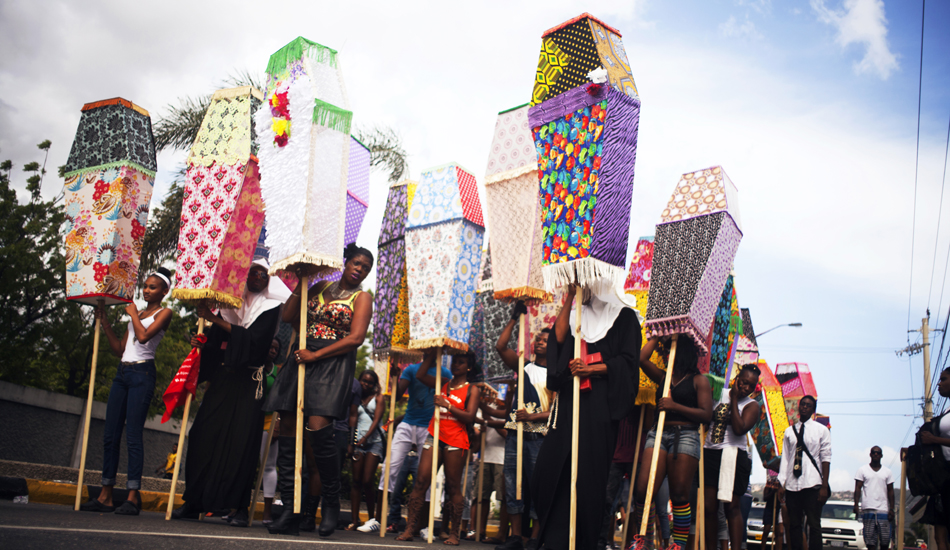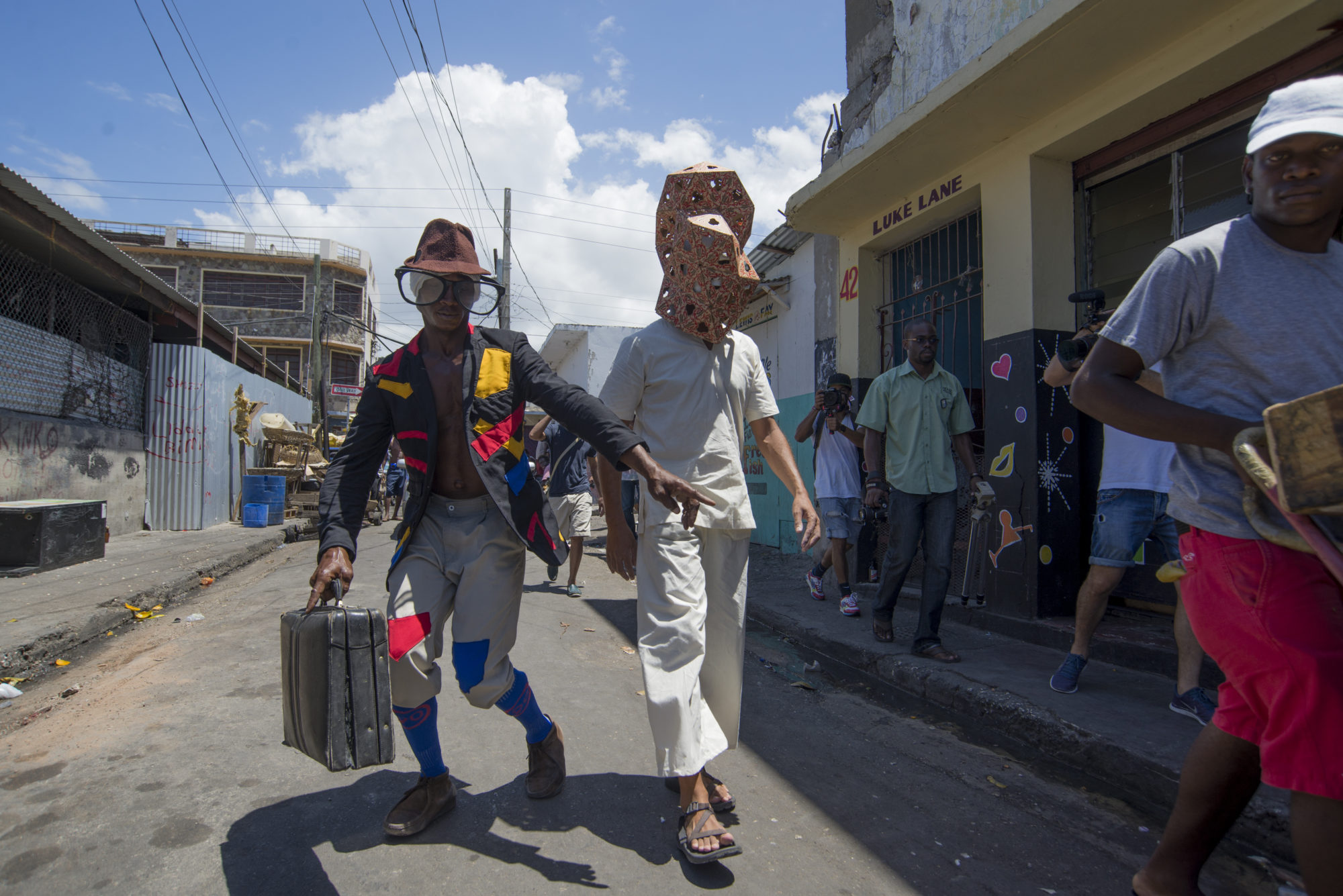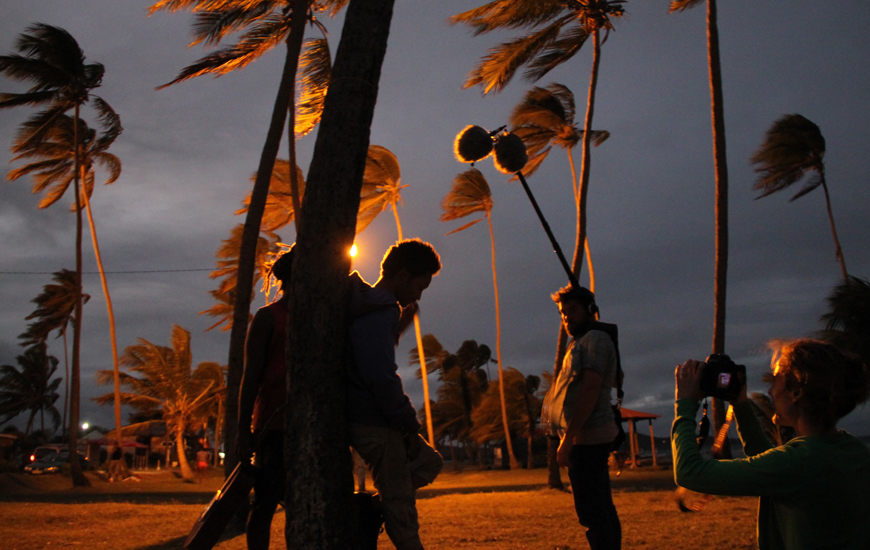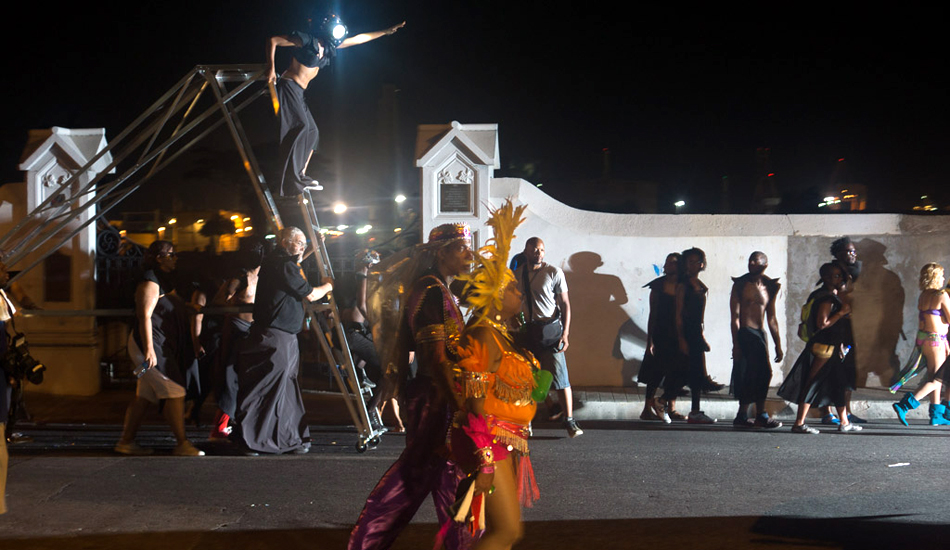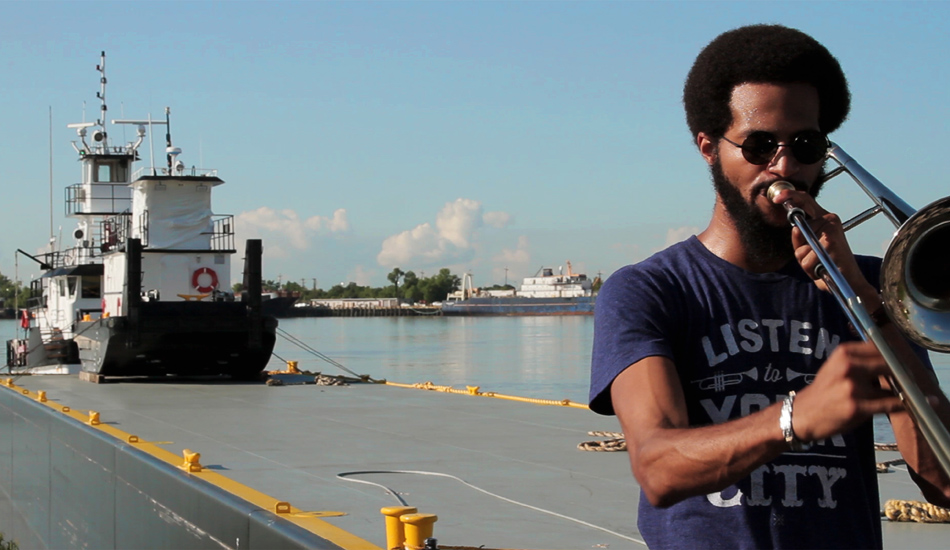
Cauleen Smith, H-E-L-L-O videostill, 2014
Claire Tancons
The curator illuminates the centrality of mass processional performance in cultural identity formation and contemporary artistic practice—as well as its political and emancipatory potential, globally—as her latest project, EN MAS': Carnival and Performance Art of the Caribbean, opens in New Orleans.
Share:
Claire Tancons is a New Orleans-based curator, writer, and researcher whose work in recent years has reached global audiences through a pioneering approach to large-scale performance. A native of Guadeloupe, in the French West Indies, Tancons has curated many projects over the last decade that feature novel artistic and curatorial ideas stemming from Carnival, civic rituals, popular movements, and public ceremonial culture at large. Among the most noteworthy were historically grounded mass processional performances presented at venues including South Korea’s 7th Gwangju Biennale in 2008; South Africa’s CAPE 09, the second Cape Town biennial in 2009; and Sweden’s 2013 Göteborg International Biennial for Contemporary Art. In 2008/2009 Tancons served as associate curator for the Prospect.1 New Orleans international biennial, and last year she was invited to London by Tate Modern to curate a performance in Turbine Hall as part of its BMW Tate Live series. There, her large-scale Up Hill Down Hall: An Indoor Carnival reflected her goal of “expanding the historical purview of performance to more fully engage African diasporic and circum-Atlantic perspectives in art history and curatorial practice.”
This March, the Contemporary Arts Center New Orleans plays host to the Emily Hall Tremaine Exhibition Award-winning EN MAS’: Carnival and Performance Art of the Caribbean, an international touring show that Tancons initiated and co-curated. Her approach is unique for its Caribbean-inflected emphasis on Carnival, in Tancons’ words, “as a form of political aesthetics situated within African diasporic art historical discourse and contemporary curatorial practice.” In contrast with Europe, where Carnival ceased to be a defining influence centuries ago, postcolonial Caribbean nations have long embraced a liberational component through their Carnival-centric cultures, infusing the festivities’ broad vernacular appeal with sensibilities that have much in common with contemporary protest and liberation movements elsewhere in the world.
Nicolas Dumit Estevez, C Room, 2014 [photo: Raymond Marrero]
D. Eric Bookhardt: When did you first begin exploring notions of the carnivalesque and developing the idea of Carnival as an art form in its own right?
Claire Tancons: I did not have any preconceived ideas about Carnival when I started out. I was born and grew up in Guadeloupe, in the French West Indies … but I like to say that I “became Caribbean” in 2004 vicariously, through Trinidad, after leaving Guadeloupe at 17 and going on to study art history, museum studies, and curatorial studies in Paris, London, and New York—at the École du Louvre, the Courtauld Institute, and the Whitney Program, respectively. It’s really in Trinidad that I rediscovered Carnival—and the Caribbean for that matter—when I was invited to be a curator-in-residence at a small but vibrant cultural center that has since folded. Trinidad is known for its great Carnival, although at that time I had no idea what that really meant. During my stay in 2004, I noticed that most contemporary art there revolved around Carnival—whether in photography or film, sculpture or installation—and I met many of the most accomplished artists in the field, as well as a younger artist, Marlon Griffith, with whom I’ve since worked repeatedly. At the time Griffith was doing a gallery installation employing vacuum-forming techniques of the sort used to produce molds for masks and costumes for Carnival, as a way of creating elaborately patterned shadows that were then projected onto the walls. When I saw the work he was doing as a masman [Trinidad’s term for Carnival designer] a couple of months later, during my first Trinidad Carnival, I [told] him, “Marlon, you know, you can bring your gallery art practice and your Carnival design practice together, and let that be your contemporary art practice.” Through this and other conversations I came to realize that while there was a great interest in and drive towards Carnival, there was also at times a disconnect in terms of how it could become a more fully developed contemporary art practice.
Christophe Chassol, BIG SUN, video still, 2014 [image courtesy of the artist]
DEB: You have written extensively on the artistic appeal and political potential of the Trinidad Carnival and its impact on contemporary artistic creation, popular movements, and mass spectacle.
CT: In Trinidad, if you are a visual artist, someone you look up to and whose practice you aspire to emulate is Peter Minshall, who is both very well-known and largely under-recognized, at least in a mainstream contemporary art context. Minshall has a background in theater design, in which he was formally educated in London. He is someone who holds a particular place in the realm of the Carnival arts in Trinidad and throughout the Caribbean for his unique ability to bring out an operatic grandeur and ambitious programmatic and societal commentaries in his mas bands, which have tackled corruption and the AIDS crisis, as well as more symbolic subjects rooted within Caribbean culture, yet of unmistakably universal reach. At the apex of his career in the 1990s he was widely known: he carried out an antinuclear protest in Washington, DC, and designed the opening ceremonies for the 1992 Barcelona Olympics, for the 1996 Games in Atlanta, and … for the 2002 Winter Olympics in Salt Lake City.
Why would anyone aspire to design the opening ceremonies of the Olympic Games? Why should that be considered so great a goal or worthy an endeavor? Of course, this is what Cai Guo-Qiang, the contemporary Chinese artist, did—and to great acclaim—for the Beijing Olympic Games. But what I find interesting is that, at a time of the globalization of mass protest on one hand, and of the massification of museum and biennial culture on the other, it can be meaningful to try to come to terms with this notion of “the masses,” to find media that involves, as well as merely engaging … them. I’m not saying that mass protests or the Olympics, which are on opposite ends of the spectrum, are the ideal platforms for [such a thing], but that Carnival’s massive reach, though largely depoliticized and increasingly spectacularized, has holding potential for the expression of a cultural commons through mass engagement. This was reflected in the Occupy movements, for instance, with carnivalesque performances, if not Carnival per se, resurfacing in anti-global-capitalist protests. Although anti-global-capitalist activists explicitly refer to Rabelais’ notion of the carnivalesque and pit “Capital” and “Carnival” against each other—think Reclaim the Street’s Global Carnival Against Capitalism in 1999—I’m interested in rooting this relationship in the historiography of the Americas as [the site of both] development of proto-capitalism, and of the modern reemergence of Carnival.
DEB: So how exactly do you see, or interpret, this relationship—or dichotomy—between Carnival and Capital?
CT: As we know, Carnival was thriving in Europe in the Middle Ages under conditions of servitude and feudalism. One can understand, if only schematically, how the conditions of colonialism and slavery produced similar situations and circumstances of profound power imbalances. In the mid-20th century, when independence movements occurring in former colonies affected the evolution of Carnival as it became part of the official cultures of new Caribbean nations, it was promoted to the rank of a national art. This was clearly the case in Trinidad, where Carnival became a promotional vehicle for the new government in the 50s and 60s, and, some would argue, constrained it as an object of spectacle. Around the same time, the Caribbean people began to immigrate to London, New York, and Toronto, where they set up diasporic Carnivals that responded to the injustices, segregation, and racism to which populations of color were subjected, by showcasing their communities’ strength through the resilience and creativity of their public culture. That’s the history of the Notting Hill Carnival, the legacy [from] which I drew … for the project at Tate Modern.
In the late 20th and early 21st centuries we have started to see the rise of what the French economist Thomas Piketty, author of Capital in the Twenty-First Century [2013], refers to as “patrimonial capitalism,” meaning that it is now more profitable to fortify and manipulate money than it is to earn money through work. So in a way patrimonial capitalism is the new feudalism—the 0.1% versus the 99.9%—and the kind of circumstance under which Carnival can thrive as a revealer and corrective of the extremes at both ends of the spectrum.
Hew Locke, Give and Take, 2014 [photo: Akiko Ota] co-produced with EN MAS’: Carnival and Performance Art of the Caribbean, curated by Claire Tancons and Krista Thompson, Contemporary Arts Center New Orleans and Independent Curators International, 2014-2017.
DEB: So how has your sense of Carnival’s potential scope and impact evolved in the decade since your Trinidad residency?
CT: There are really two strands of interest in terms of what I’ve been doing. Early on, one was very much about showing the artistic nature of so much of what goes into producing work for Carnival, and highlighting those carnavalescos, masmen, and contemporary artists, oftentimes of Brazilian and Caribbean descent, who do very interesting work within the performance aspect of Carnival. I’m thinking here of Brazil’s Joaosinho Trinta and Trinidad’s Peter Minshall for the Carnival designers; artists Jarbas Lopes, Laura Lima, and Arto Lindsay for the Brazilians (well, Arto’s American but he’s culturally and artistically Brazilian); and Marlon Griffith, Hew Locke, Laura Anderson Barbata, Mario Benjamin, or Nicolás Dumit Estévez for the Caribbean. This [pursuit] also involved attempting to define a critical context through which these artists’ work could be understood, and providing a curatorial framework within which it could be showcased.
Another strong interest—which was strengthened by the carnivalesque trends within Occupy Wall Street, which I wrote about in 2011 in an e-flux journal article that was just republished in the anthology The Political Aesthetics of Global Protest: The Arab Spring and Beyond [2014]—is the promise of Carnival as a form of public address. I realized that what really drove me was understanding the conditions of the emergence of Carnival: why is it, and when is it, that Carnival resurfaces within the historical record, and under which new guises? After all, it’s a foundational civilizational principle that never really died out but only morphed over the ages. This rise of patrimonial capitalism is one of the conditions that I believe is very propitious for developing a sense of the carnivalesque, just as it was propitious for the development of Carnival as a rite of power inversion to take root in the Caribbean in the aftermath of the Middle Passage.
In the context of the art world, we hear a lot about participatory performance, and about the need for social engagement or community outreach, yet it strikes me that all of these modes of agency are very much already an integral part of so many public ceremonial practices. We know this full well here in New Orleans with the weekly second line parades of the social aid and pleasure clubs—mutual aid organizations that have developed a keen sense of social activism and political organizing through artistic pageantry. So it’s been interesting to try to work on these various problematics from the inside out, or from the ground up, as opposed to attempting to artificially devise new modes of engagement, where really—at least, in the places in the world [where] I’ve been fortunate to live and work—there are already existing apparatuses through which to achieve these goals.
Ebony G. Patterson, Invisible Presence: Bling Memories, 2014, Jamaica, for En Mas’: Carnival and Performance Art of the Caribbean, curated by Claire Tancons and Krista Thompson, Contemporary Arts Center New Orleans and Independent Curators International, 2014-2017 [courtesy of the artist and Monique Meloche Gallery. photos: Monique Gilpin and Philip Rhoden]
DEB: You have an exhibition opening in March at the Contemporary Arts Center, EN MAS’: Carnival and Performance Art of the Caribbean, that’s been years in the making. Could you tell us a little more about this project?
CT: EN MAS’ will be the culmination of my long-standing engagement with Contemporary Arts Center New Orleans around the production of a Carnival project. It began in 2009 with the formulation of a broader, more global project that later zoomed in on the Caribbean after I invited art historian and Northwestern University Associate Professor Krista Thompson to collaborate, and finally got into motion in 2012 following our winning the Tremaine Exhibition Award. The project unfolds in three phases: the first consists of a series of nine commissioned projects by artists who have a history of engagement with Carnival and related masquerade or festival practices throughout the Caribbean and its North American and British diasporas. As an attempt to map out the 2014 Caribbean Carnival season, I spent the year traveling to Santiago de los Caballeros, Dominican Republic, for Nicolás Dumit Estévez’s performance; then to Port-of-Spain, Trinidad, for Marlon Griffith; to Kingston, Jamaica, for Charles Campbell and Ebony Patterson; and back to New Orleans for Cauleen Smith’s film shoot. In the midst of this, I also continued a two-year conversation with Lorraine O’Grady, whose project became so big that it’s now gone beyond EN MAS’ and is slated to have a long afterlife. I also invited Hew Locke to present his performance, Give and Take, as part of Up Hill Down Hall, making his EN MAS’ project a CAC-Tate co-production.
The second phase of EN MAS’ has consisted in bringing all the photographic and video documentary materials, as well as installations designed specifically with original or refabricated elements, from the performances into the exhibition, and [in] bringing together essays by accomplished critics and academics located for the most part where the performances took place, into an exhibition catalogue. As for the exhibition, I feel fortunate to be able to work again with Gia Wolff, an architect doing research on the parade float as a form of community architecture, with whom I collaborated on the Tate Modern project, and [whom I] subsequently invited to be the exhibition designer for EN MAS’. It’s not every day you find an architect interested in Carnival, although in hindsight some of the greatest have been: Oscar Niemeyer designed the Samb—dromo, Rio de Janeiro’s iconic Carnival stadium, and Herzog & de Meuron were part of Carnival “cliques” [Carnival groups] in the Basel Carnival and, of course, renovated the Turbine Hall at Tate into a very processional space.
The third phase for EN MAS’ will be its national and international tour, organized by Independent Curators International. They readily took on the challenge to bring the exhibition back to every single venue where the commissioned projects took place, which means a great deal of exhibiting in the Caribbean. It’s a testament to ICI’s commitment to global practice and engagement with non-mainstream artistic narratives.
DEB: Although New Orleans is often described as the northernmost city of the Caribbean, the diaspora that gave it its defining Creole cultural identity actually occurred more than two centuries ago. How does this heritage affect your work?
CT: New Orleans is a unique place where the centrality of mass processional performance could really be made more visible within a variety of artistic contexts. But perhaps these practices should continue to escape that mainstream in order to retain their audacity and vivacity—something that the great arts organization New Orleans Airlift has successfully encouraged. So there is some give and take in showing that goals like community outreach and social engagement can be achieved through these various left-of-mainstream forms. On one hand, you want to continue protecting these cultural practitioners and, indeed, artists, by providing them with the means for continuing their work; on the other hand, you want to bring them the artistic recognition they deserve.
Charles Campbell, Actor Boy: Fractal Engagement, performance, April 21, 2014, Kingston, Jamaica for EN MAS’: Carnival and Performance Art of the Caribbean, curated by Claire Tancons and Krista Thompson, Contemporary Arts Center New Orleans and Independent Curators International, 2014-2017 [courtesy of the artist; photo: Marvin Bartley]
DEB: You realized two projects with New Orleans Airlift in 2014. How do you reconcile these less formal productions with your more institutional projects?
CT: Delaney Martin, an artist and the artistic director and co-founder, with Jay Pennington, of New Orleans Airlift, is another collaborator I feel very privileged to work with. Over the past year, we co-organized two exhilarating, wild, by-the-seat-of-our-pants, low-budget performances: the Rally Under the Bridge in May, and Public Practice as a satellite event during Prospect.3’s opening weekend in October. The former, commissioned as part of Microsoft’s One Million Square Feet of Culture series, took place at a remote location at dusk. The latter took place in glaring daylight in the St. Roch neighborhood during a gun buyback project initiated by another formidable lady and former St. Roch resident, Kirsha Kaechele, of Tasmania’s Museum of Old and New Art. Both were highly experimental and featured a wide spectrum of participants that included rappers, veteran Mardi Gras [Indian] Queens, preteen neighborhood kids, young-adult horse riders, and a female motorcycle club; and involved custom cars, tricked-out bikes, live music and DJ sets, coordinated dancing, choreographed rides of all kinds, and symbolic releases of doves, among other activities. All participants received an honorarium, in addition to being provided with basic production material. [These last details are] very important because these creative practices all reflect and occur within what I think of as New Orleans’ marginalized cultural mainstream, where they are typically taken for granted. This alternative cultural mainstream is of course the one that takes places in the streets and is typified by the weekly second lines, neighborhood brass band parades whose costumed participants take part in performances that have been described as resembling a “jazz funeral without a body,” and that typify this city’s innately carnivalesque street culture.
The outcomes of these collaborations were eye-opening, heartwarming, and unclassifiable performances that were both totally true to this city’s psyche and way “out there” among experimental contemporary artistic and curatorial approaches to participatory performance. They do the work of social justice—Public Practice was an antiviolence community ceremony for the gun buyback—without even trying, just as they engage with communities without pushing, through a profound respect and deep appreciation for what they do beyond normative artistic frames. New Orleans has a long-standing history of creative carnivalesque traditions that has survived for centuries. As a mode of mass empowerment, the value of Carnival and the carnivalesque resides in both their adaptive capacity and their broadly rooted aspiration for freedom and creativity. So there is much to be learned from places where—to quote a local aphorism—”the culture bubbles up from the streets rather than being handed down from on high.”
Christophe Chassol, BIG SUN, video still, 2014 [image courtesy of the artist]
Marion Griffith, POSITIONS + POWER, 2014 [photo: Arnaldo James]
D. Eric Bookhardt is a contemporary art and culture writer and essayist. A former research archivist at the Museum of Modern Art, he is a longtime contributing editor of ART PAPERS and art critic for Gambit Weekly in New Orleans. His publications include several books and museum catalogue essays as well as reviews and features for publications including Art News, Art in America, Utne Reader, Sculpture Magazine, and Public Art Review. He serves as president of the Center for Gulf South History and Culture and is the editor of the New Orleans Art Insider website.
